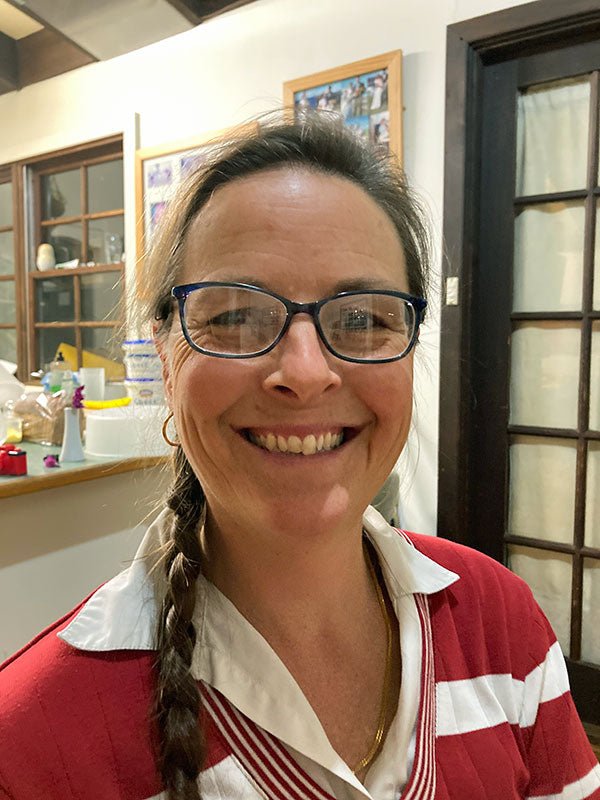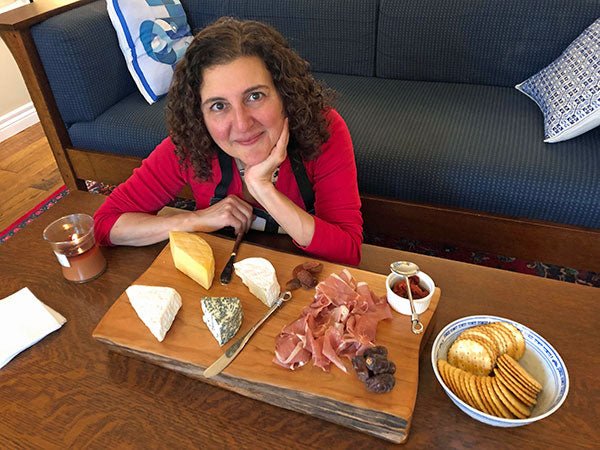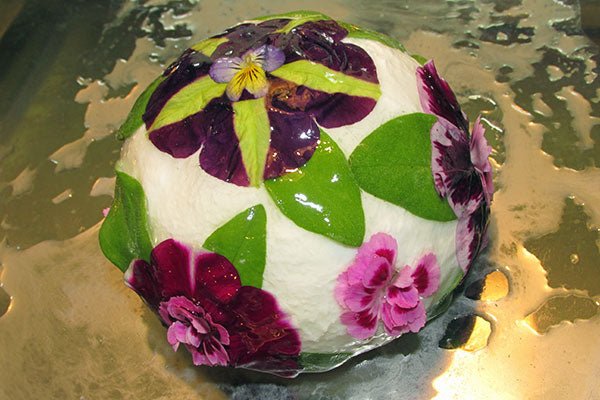Amanda Lockwood told us “Some days I try to do too many things😂.” That seems like quite an understatement!
She has 4 children and 3 grandchildren with 2 teenagers living at home. She teaches for a living, she maintains a large garden and she is the proud owner of a milking cow which enables her to make all kinds of dairy products.
She used to buy 30 litres (8 gallons) of milk a week but demand has gone down as children have moved out. She told us, “I don’t drink a lot of milk after seeing the rate of growth of the calf. If I drank milk all the time I would grow at the same rate!”
Amanda’s Story
I was born in Sydney in the early 1970’s and my family moved to a 5 acre block soon after. My Dad built our house and Mum made a great vegetable patch and chook house. They had a very little money, a dream to be self sufficient and a can-do attitude which has been passed onto their children.
The land was sandy, rocky and infertile – not a great place to raise a dairy cow. My parents bought a Jersey cow to feed my teenage brothers and I. The milk was beautiful and Dad made milky porridge every morning. Mum made yogurt but it was very tart.
We are so lucky now to have pure cultures to achieve a consistent result. I remember the beautiful creamy taste of the milk on cereal and wanted my children and grandchildren to experience pure milk.
Australia is a big place and I better tell you about the region where we live. Orange is a regional centre located in the central west area of New South Wales. That is inland (about a 4 hour drive from Sydney).
The elevation is 900 metres (3000 ft) so we have crisp winters with occasional snow.
Even though the town is called Orange and is a major agricultural area, it grows mostly apples, pears, figs, chestnuts, truffles and has many boutique wineries.
There are many cellar doors open and tourism is becoming popular. We even have an artisan cheese company called Second Mouse Cheese Company.
My First Cheese Making Experience
I first made cheese at the University of Western Sydney, Hawkesbury. I was studying for my Bachelor of Food Science (Food Technology) in 1992.
They had a pilot plant with all sorts of machinery to teach us all how to preserve food. They had a dairy as they also teach Agriculture and they sold the foods we made in a shop on campus.
The vat they had for making cheese was huge. We made a cheddar but, due to the scale, I never considered it possible to make it from home. Thank goodness for the internet!
Working From Home
I had been a high school teacher for 13 years, but then, our first grandchild was born and it reminded me how wonderful children under 5 can be. So, I changed careers to work from home.
In Australia, we have Child Care Centres and Family Day Care. Family Day Care has the same rules but a family day care educator has the children in their safety approved home and they have a lower child-to-adult ratio.
Each day we look after the garden and the animals – I have a sustainable focus. The children love feeding the chickens, goats and even the worm farm. Children just love being outside.
Everyday we run, paint, balance and care for each other. It is fantastic to teach them to make compost and grow plants from seeds, and they love eating plants straight out of the garden. They even eat kale!

I try to maintain a permaculture-style vegetable garden. Feeding the soil is my goal. All these broccoli, kale, spinach and lettuce have self sown. I am learning medicinal plants to make salves with our bees wax.
I am lucky I work from home so I can work around making cheese.
My Crazy Goats
I bought a goat to milk when the Government brought in dairy deregulation in 2000. Dairy farmers no longer received a fair price for their milk. Since then, the dairy industry has suffered and it has seen 80% of dairy farmers leave.
Goats were difficult to keep in. I started out with a nanny and kid but I became a unofficial goat refuge and, at one stage, I had 40 goats. We had plenty of land and food but the goats always wanted the greens on the other side of the fence.
We knew they had to go when our kind neighbours had to extend their fence to stop our goats from eating their garden.
I also had issues with milk taste. I tried cooling the milk fast but it was too variable. The family went on strike and were not keen on the milk, as it was like breakfast roulette.
Goats have wonderful personalities but now that I have a cow, I wish I had gotten one 15 years ago!
My Lovely Cow
When I mentioned to my husband I wanted a milking cow, I think he thought I was mad. He was quiet and hoped I would lose interest.
My adult daughter was keen and drove with me the 13 hour round trip to pick her up. She even negotiated with the farmer to buy a poddy (newborn) calf – Pattymoomoo.
The trip was pretty tricky with my people-mover towing a hired cattle trailer and we nearly ran out of fuel but we made it home eventually. By the morning, Jeanie Jersey had accepted Pattymoomoo, which was a huge relief!
Cows are the ultimate animal – they are so generous. Our cow, Jeanie Jersey is an ex-dairy cow who is a reluctant house cow. She is a bit cranky but is mostly all head toss and no action although I do tell the grandchildren not to turn their back on her!
My daughter was much better at hand milking than I was and my lovely husband built a study stanchion.

It turns out cows are very messy eaters so I put down a table cloth to catch the mess and then put it back in her feed bin.
For me she has been a steep learning curve. I tried to milk by hand but I was way too slow. Jeanie was used to machine milking at the dairy she came from and I was very worried that she would get mastitis, so I bought a milking machine.
It is the best invention, right up there with a dishwasher. I milk Jeanie every morning after separating the calf for the night.
The cow gives us between 8-12 litres (2-3 gallons) each morning and I am glad I don’t get more! The milk needs management to use the oldest first. I hold back 2 litres (1/2 gallon) each day for emergency fresh use and make a hard cheese when we get a spare 10 litres (2 1/2 gallons).
This took a while to get used to but we use all our milk within 2 days. Our needs can fluctuate with visitors, but I usually make 10 litre (2.6 pound) hard cheeses and use 4 litres (1 gallon) for fresh products such as yogurt, fromage blanc and feta.
My plan with the cow initially was to cow share. Cow sharing is when multiple families milk a cow on separate days.
I had been listening to podcasts on community building and thought it was a great idea but I did not factor in the cow not letting her milk down with strangers 😂 or the reluctance of people to get up early to milk a cow. Plenty of people want the milk but there are heavy fines for the sale of unpasteurized milk.
I had been listening to podcasts on community building and thought it was a great idea but I did not factor in the cow not letting her milk down with strangers😂.
Cows can be a bit scary at first so my share idea was scrapped. I now share cheese tasting with friends and that is pretty good community building.

This is a Stirred Curd Cheddar using Ricki Carroll’s Recipe from Home Cheese Making. The taste is gorgeous, smooth and tasty. Using less rennet for fresh milk is essential to prevent bitterness.
My Yummy Cheese
The milk is so delicious and precious, I had to work out how to preserve it.
I had been making my own feta before Jeanie arrived and then my husband bought me a hard cheese kit from the local home brew store. With a little help from Little Green Cheese and Gavin Webber’s YouTube videos, I was off and running.

This is my first cheese (Stirred Curd Cheddar, Ricki Carroll’s recipe) where I used our own beeswax. I used a ratio of 2 parts wax to one part oil. It cracked after refrigeration so I will have to add more oil next time.

This is Belper Knolle at the ‘rolling in roasted, cracked pepper stage.’ Belper Knolle was amazing and was great eaten fresh. Some have lasted for aging but the lovely fresh garlic and pepper was delicious.
I like to take photos and videos of cheese making to share with friends and family. I have been sharing videos of gardening, propagation and sustainable practices for a couple of years to help people to understand how to care for our planet because we all need to understand how to care for our fragile earth.

This is my first attempt at blue cheese. It has been very popular with blue cheese fans. It is disappearing fast so it is good I have a few more ripening.
My students and I make milkshakes every day. The children absolutely love it.
I make Greek style yogurt and strain this to make labneh. This makes a great dip base and the children love dipping carrot sticks in it when it’s only flavoured with salt and pepper.
I also love the cream from the cow.
We make ice cream when there is plenty. Our favourite is honey flavoured. My husband has kept bees for years and the honey is exceptional. Combine Jersey cream with honey to make ice cream and it is quite amazing. (Goat milk has very small fat globules which is great for digestion but not easy to separate.)

This is a frame from a queen rearing hive my husband is growing. We had just marked the queen with pink marker.
I make fromage blanc which we whip with a little cream and vanilla to make a gorgeous topping with fresh fig jam and sourdough toast.

This is my fromage blanc with homemade fig jam, local toasted hazelnuts and fruity sourdough toast. We have beautiful produce in this region.
I also made cheesecake with the fromage blanc, but that recipe needs a bit of tweaking as it was very heavy.
I make feta for salads and quiche. It is also a good gift for friends when stored in oil and herbs.
My brother said he liked havarti, so I made that for awhile. The flavour is quite nice but it is a bit strong for our everyday use.

Havarti. My second attempt and best Havarti so far – smooth and buttery. My first attempt was dry, possibly from stirring too much and had too much white mold that changed the flavour but I have discovered regular brining makes a huge difference.
I have found I like to make a cheese until I can perfect the technique, then I move on to another.

I take a photo of each cheese with the date and I can then match it with the cheese log. (I may make a few different cheeses a week so they can begin to look the same.)
We have found a favourite in Colby, using Gavin Webber’s recipe.
I am still experimenting with amounts of culture and rennet. Fresh milk seems to require less of both. My attempt at Camembert was woeful. It was way too strong for us but others thought it was great (some people’s taste buds have been desensitized).
I have been fascinated by the change in texture of the cheese over time. A great example is Queso Fresco – it is quite springy to start with but it has a great stretch when heated. Then, when it is older, it becomes soft and mellow.
My family also likes baked custard so I have not wasted a drop of milk. The whey makes ricotta or it is given to the pigs or it is put on the compost. I have found it such a fun hobby to use all the milk.
I do not pasteurize the milk but I try to be very clean and use only yesterday or today’s milk. If I am going away, I give it to other cheese makers.
I now have other cheese makers wanting Jeanie’s milk to try the difference between raw and pasteurized. They love it.
I have never had a problem with the curd set – usually my issue is following the steps on time. Uniform cheese is a long way off for me. There are so many interruptions, I don’t think I will ever have two cheeses the same😂.
Tools of the Trade
It took a while to learn the temperature of my stove and to learn how to manage it. The timer in my phone is essential! I use a timer to remind me it is time for the next step – otherwise the curds may never get cut!
I soak my cheese cloth in an iodine solution and spray my equipment after washing with propionic acid. I spray my hands with vinegar before handling curds or cheese.
I also now spray the containers I put fresh cheese and yogurt in before I use them to prolong the life of the product. I have learned to be hygienic as it is time consuming and wasteful not to be.
We were given a cream separator made before 1950. It worked so efficiently that the cream was so thick it was nearly butter. I whipped it up and it was amazing.

Cream separator. We have only used it a couple of times as it is easier to skim cream off the top of the milk.
A possible obstacle to cheese curing is the cheese cave. Initially, I got a wine fridge, which is great, but it fills quickly. If you are making soft cheese, the containers to keep the cheese humid are large.
If you have the space, you can use a broken fridge. Pop a frozen ice block in the bottom with a thermometer and it can stay in the temperature range you wish by adding more or less ice. Just refresh your ice pack (I use a frozen 2 litre (1/2 gallon) milk bottle).
A Little Advice
If you want to make your own cheese – watch some videos, buy a kit and use good quality milk.





























































































































































